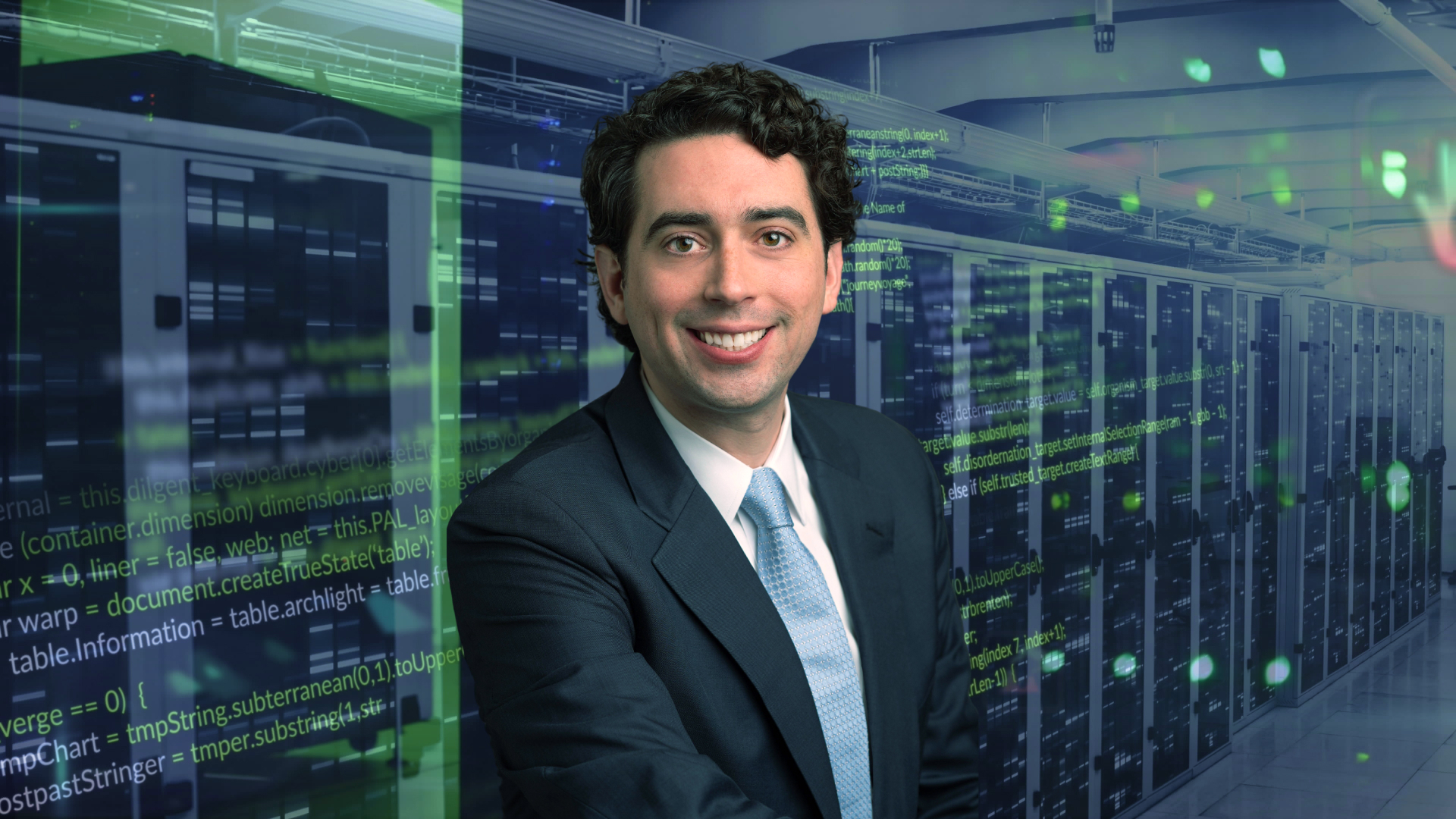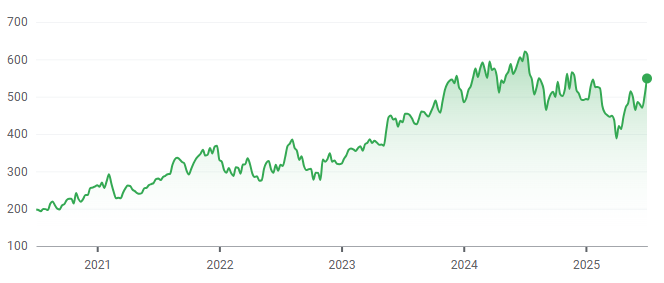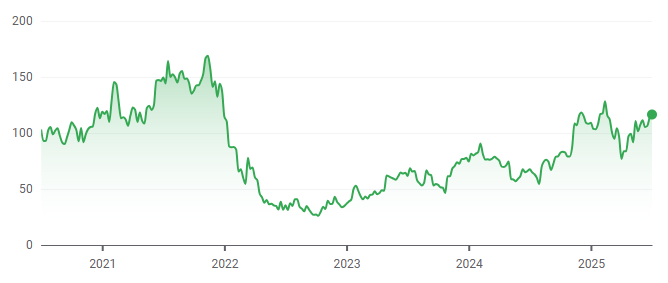The surprising resilience of big tech and 2 stocks for coming years
The first half of 2025 has been an interesting (and challenging) time to be a tech investor. It has also highlighted how essential technology like AI has become to the global economy, and in fact, spending in this space saw little impact despite the uncertainty created by “Liberation Day” and initial reactions to DeepSeek. Recently, the US-UAE GPU deal to supply 500,000 Nvidia chips annually to the Gulf region demonstrates the ongoing global importance of AI, establishing the Gulf as an AI hub and ensuring US dominance in the AI space.
For Dominic Rizzo, Global Technology Portfolio Manager at T.Rowe Price, it’s hardly surprising we’ve seen a resurgence in big tech, bringing the S&P 500 to record highs by 30 June (despite the 16% tech correction in April).
“AI leadership is imperative for American corporations, hence spending remained remarkably resilient, despite rapidly evolving geopolitical and macroeconomic challenges,” he says.
Rizzo’s portfolio was able to outperform even during the April correction, thanks to a careful approach to investing in AI and the broader technology space. In this interview, he shares his framework for identifying tech winners, how he managed through uncertainty, and the emerging tech themes he is excited about.
He also discussed two AI beneficiaries outside of popular names like Nvidia, AMD and Taiwan Semiconductor for investors to take a closer look at.

The three most significant events for big tech in 2025 (so far)
Rizzo points to three significant events of 2025 as being critical in shaping the path of big tech and AI going forward.
US President Trump’s “Liberation Day” on April 2, 2025, had far-reaching implications across the globe, but Rizzo explains that the resulting supply chain transitions were significant to the tech industry and will continue to be so.
“Tech companies responded with unprecedented urgency, restructuring supply chains from Asia towards the Americas, particularly for semi-conductors,” says Rizzo, pointing to Nvidia’s May earnings call where CEO Jensen Huang outlined the company's strategic initiative to build a comprehensive AI infrastructure - ranging from chips to supercomputers - entirely within the United States by the end of the year.
This event was also responsible for the 16% tech correction, with Rizzo explaining he took the opportunity in this period to trim the portfolio's highest-multiple US software positions like ServiceNow (NYSE: NOW) and move capital into quality cyclicals like ASML (NASDAQ: ASML) and Entegris (NASDAQ: ENTG), which were suffering weakness.
“My playbook was to stay disciplined and take selective risks in semis. We are now up to a 700bps+ overweight in semis, but used names like SAP as defensive ballast in the downturn,” he says.
The second major event was the announcements around DeepSeek, which particularly affected the prices of Nvidia (NASDAQ: NVDA). Rizzo comments that “initial reactions now seem almost comical”, and it has now been a positive for AI.
“Its low-cost LLM reset model economics, but this merely accelerated AI consumption. With 90% lower inference costs, every workflow becomes agentic-ready, driving chip demand higher,” Rizzo explains.
He maintains a high conviction in Nvidia, with structural demand for semiconductor chips expected to increase from $45 billion in AI chip spend in 2023, to $450 billion in 2027, and to $500 billion in 2028.
“Nvidia took an approximately $5 billion write-down and still beat Street numbers! That’s financial resilience you rarely see,” he says, adding, “silicon demand is becoming more structural – AI, automotive, industrial internet of things (IoT) all require more chips.”
While it may have perhaps slipped under the radar compared to other US activities, the US-UAE GPU is also significant in Rizzo’s opinion, as a long-term play to maintain US dominance in the AI space and create an AI hub in the Gulf.
Picking winners and managing through uncertainty
In any major theme, there will be winners and losers. Just look at the dotcom bubble as one example, but like the internet, AI will become essential. Investors simply need to be disciplined in how they approach investing in this space.
“It’s important to have a reflexive framework to understand the interplay between fundamentals, valuation and market psychology,” Rizzo says.
T.Rowe Price’s framework aims to “look for linchpin companies that are creating/selling key products and services in growing markets, where the fundamentals (sales, margins, free cash flow) are improving and don’t overpay.”
Rizzo adds that he looks for catalysts for the ongoing growth of a business.
“Look for companies where AI creates operating leverage, for example, EDA tools with agentic design capabilities, platforms benefiting from inference cost deflation, cybersecurity where threats are accelerating faster than traditional defenses,” he says.
He also asks himself, “Who are the imposters?” This has led him to eliminate most application software from his analysis and to continue finding infrastructure players appealing.
He found sticking to the fundamentals was critical during market uncertainty, particularly in the April correction. As mentioned earlier, he also took the opportunity to trim higher valuation positions and direct capital into those with weaker share prices.
“The vast majority of our book is in companies with improving fundamentals. When volatility strikes, and we still believe in those improving fundamentals, you stay with these types of winners,” he says.
Rizzo’s portfolio is tilted towards semiconductors, with software the second largest play (though a significantly lower allocation. He notes the structural demand growth in AI chips as being key to his rationale for weighting his portfolio in this way, holding a high conviction on Nvidia, Advanced Micro Devices (NASDAQ: AMD), Taiwan Semiconductor (TPE: 2330), Synopsys (NASDAQ: SNPS) and Cadence Design Systems (NASDAQ: CDNS).
By contrast, “US software trades at high sales multiples and AI is making the environment increasingly uncertain.” He likes software companies to “own the plumbing” and favours Amazon (NASDAQ: AMZN) and Shopify (NASDAQ: SHOP) in this space.
The AI investment cycle and where to watch
We are currently in the second phase of the AI investment cycle, which Rizzo describes as “the infrastructure land-grab with debt financing extending beyond equity.”
While Rizzo notes that third-party capital financing hyperscale clusters suggest a bubble, he argues it is different to 2000 - “this infrastructure generates immediate ROI”. He notes that it can last for a considerable amount of time.
The areas he is looking at include:
- Areas/companies that can capture the value they create, such as computing, chip design and manufacturing and cloud landlords like Microsoft or Amazon who “monetise first and set the toll-booth rates”.
- Generative AI and agentic workflows that remove human click streams and cybersecurity layers. He finds names like Cyberark interesting.
- Migrating gradually from silicon to platforms owning agentic data loops.
“Phase three of the cycle will start when inference costs fall another 50% - which could happen by late 2026. Until then, we will likely stay overweight the picks-and-shovels,” Rizzo says.
Other emerging tech themes to watch
AI dominates discussion but there are a few developments that Rizzo is excited about.
“Power efficiency is gaining traction, with companies like Infineon and advancements in wide-bandgap semiconductors meeting increasing server and electric vehicle power demands, where productivity gains surpass consumption concerns,” he says.
He is watching quick-commerce, such as Alibaba’s AI-enabled delivery strategies, which use AI-driven logistics, highlighting that this is reshaping retail and offering sustainable competitive advantages.
Finally, he is also interested in stablecoins in the cryptocurrency space, which he notes has the most promising use case, particularly for cross-border payment corridors.
“While these won’t replace card networks, they provide alternative rails for currency translation. I worry about valuation in the broader crypto ecosystem,” he says.
Rizzo has also been involved with names like COIN, seeing opportunities from decentralised finance for large institutions.
“Signals I pay attention to for increased crypto allocation include regulatory clarity, such as the recent Senate stablecoin framework legislation, institutional adoption by traditional banks, and technical infrastructure maturation,” he shares.
Companies to watch outside of traditional names
Investors are familiar with the biggest names in the space, so Rizzo highlights two that he believes the market isn’t paying much attention to. He notes these are outside the GPU trade and are direct AI beneficiaries.
1. Synopsys (NASDAQ: SNPS)
“It trades at a mid-20s P/E for double-digit organic growth, while closest peer Cadence trades at the mid-30s for the same algorithm. For Synopsys, AI-driven agentic design tools push EDA growth from 11% to potentially 14-16%. And then the Ansys deal is pure upside. The valuation gap to Cadence is unjustified.”

2. Shopify (NASDAQ: SHOP)
“They are building "AI-native" checkout workflows that eliminate the eight-click Amazon experience. They have an opportunity for multi-year margin expansion driven by cost optimization and higher attach rates on ads/audiences.”

Investing in AI and big tech
If the increasing and resilient spending on AI for a range of purposes, from cybersecurity to improved productivity, is anything to go by, AI is not only unavoidable, but investors would be ignoring it at their own peril. After all, AI is an opportunity like the internet and telephone before it.
But, just like bubbles like the internet, caution is warranted. Investors could do well to learn from Rizzo's fundamental framework and take a rigorous approach to investing in this theme going forward.
Confident investing starts with curiosity
At T. Rowe Price, they ask the right questions about opportunities like health care innovation and artificial intelligence. And since 1937, actively investing in the answers that can help make the difference to your clients' investments. Learn more here.
2 topics
9 stocks mentioned


